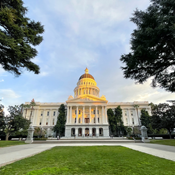
Combination Packages and Gift-Wrapping (Publication 106)
Combination packages may include food or a combination of food and nonfood items. If you create gift packages that contain only food, such as cheese, crackers, or fruit, the sale of these gift packages is generally exempt from tax. If you decide to include a nonfood product in the gift basket, it may be necessary to determine the taxable portion of the combination package. A container is generally considered the package and any packaging material that holds the product being sold.
If you maintain records that verify the cost of the individual items
This situation generally occurs when you purchase the individual components for a combination package and assemble the combination package yourself. You must continue to separate the retail value of the nonfood products when:
- You have records that verify the cost of the individual items in the package, and
- The retail price of the nonfood product is more than 10 percent of the retail value of the entire package, not including the container.
The tax is based on the retail sales price of the nonfood products not including the value of the container. For example, you have records to establish the cost of the individual items of a combination package, and your sale includes the following components:
In this example, the retail value of the nonfood item, $5.00, is greater than 10 percent of the retail value of the entire package, not including the container, ($27.00 x 10% = $2.70). Since you have records to establish the cost of the individual items of the combination package, the tax is measured by the retail sales price of the nonfood products not including the value of the container ($5.00 x appropriate tax rate).
If you do not have records to verify the cost of the individual items
This situation generally occurs when you purchase a combination package preassembled from your supplier. Tax may be measured by the retail sales price of the entire package, including the value of the container if:
- The retail value of the nonfood product exceeds 10 percent of the retail price of the entire package, not including the container, and
- You do not have records to establish the cost of the individual items of the combination package.
This would also apply if you were selling prepackaged gift baskets, since you do not have records for the cost of the individual items in the package. For example, if you do not have records to establish the cost of the individual items of a combination package and your sale includes the following components:
In this example, the retail value of the nonfood item, $5.00, is greater than 10 percent of the retail value of the entire package, not including the container, ($27.00 x 10% = $2.70). However, since you do not have records to establish the cost of the individual items of the combination package, the tax is measured by the retail sales price of the entire package, including the value of the container ($30.00 x appropriate tax rate).
If you do or do not have records to verify the cost of the individual items
The sales price of the package is nontaxable if:
- The retail value of the nonfood products is 10 percent or less than the total value of the contents (not including the container), and
- The container's retail value is 50 percent or less of the entire package value.
For example, your sale includes the following components:
The nontaxable combination package meets both conditions explained in this example. The value of the nonfood items, $5.00, is 10 percent of the $50.00 total value of the contents ($50.00 x 10% = $5.00). The value of the container, $10.00, is less than 50 percent of the retail value of the entire package ($60.00 x 50% = $30.00). Your sale qualifies as a nontaxable sale.
Please note: In these examples, we show tax calculated at a rate of 8.25 percent, however, you should use the tax rate in effect at your business location. For current tax rates, please see California City and County Sales and Use Tax Rates, or call our Customer Service Center at 1‑800‑400‑7115 (TTY:711).
Please note: This publication summarizes the law and applicable regulations in effect when the publication was written, as noted above. However, changes in the law or in regulations may have occurred since that time. If there is a conflict between the text in this publication and the law, the decision will be based on the law and not on this publication.
Revision September 2018

